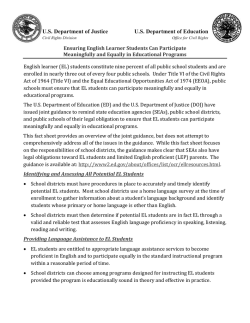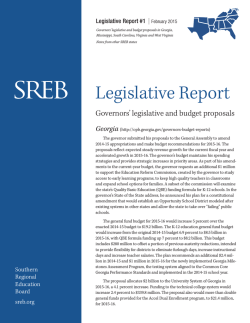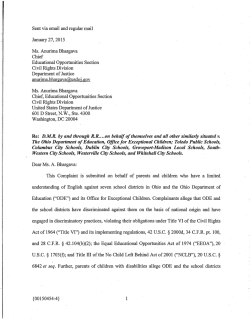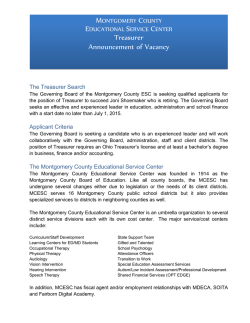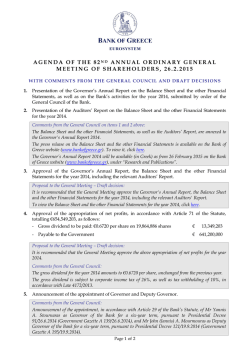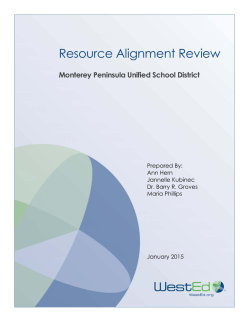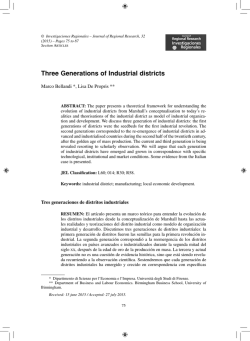
Present - School Administrators Association of New York State
*TESTIMONY* School Administrators Association of New York State (SAANYS) Presented to Assembly Ways & Means Committee & Senate Finance Committee Joint Hearing on Education Proposals of the SFY 2015-‐‑2016 Executive Budget February 3, 2015 Albany, New York 2 Introduction Good afternoon Chairman Farrell, Chairman DeFrancisco, Assemblymember Nolan and Senator Flanagan. Thank you for this opportunity to offer testimony concerning the education proposals contained in the Executive Budget for fiscal year 2015-‐‑2016. My name is James Viola and I serve as the Director of Government Relations for the School Administrators Association of New York State. SAANYS is the largest professional association of school administrators, with membership exceeding 7,000. On behalf of our principals, assistant principals, supervisors, deans and many others, I thank you for your continued advocacy and support for public education. We also applaud you for recognizing the critical importance of school leadership in our public schools. Our school leaders work indefatigably to provide quality education programs and services to their students. The importance of their work is quantified in a study published in the winter 2013 edition of Education Next. Researchers found that highly effective principals raise the achievement of a typical student in their schools by between 0.05 and 0.21 standard deviations – equating to two to seven months of additional learning per year. The effectiveness of administrators’ work is reflected in continued improvement in the graduation rate published by the State Education Department: 76.4 percent in four years as of June, 79.1 percent as of August. State School Aid Governor Cuomo proposes a $1.1 billion (4.85 percent) increase in school aid if the package of proposals contained in the executive budget are approved in full, and alternatively, an increase of $377 million (or less) if the proposals are not adopted. Moreover, Budget Director Robert Megna announced that school allocation runs will not be provided until the Legislature passes the Governor’s education reform agenda. The withholding of executive budget aid runs is unprecedented, and it appears to be an attempt to stifle the democratic process of discussing and debating important fiscal and programmatic issues and alternatives that will have profound affects upon students, educators and our State. Many school districts 3 begin planning for the next year’s budget now, and they rely upon the DOB runs for authoritative information to be used for community engagement – comparable authoritative information is not available from NYSED or other sources. In addition, the executive budget aid runs are used for property tax cap calculations. Under tax cap law, school districts are required to submit a 2016 Proposed Levy to the state by March 1 in order to calculate a district-‐‑specific tax cap figure. Without the executive budget computer runs to estimate anticipated building aid and transportation aid, it is impossible for school districts to accurately complete the required March 1 report. Withholding this information serves no good purpose, and is regarded by many to be tantamount to a bullying tactic. SAANYS is not satisfied with the status quo in terms of student performance and educational outcomes. Since 2007, school districts have been asked to do more with less, in implementing many unfunded and underfunded mandates in an uncoordinated manner, and within rushed timeframes with diminished state and local support. No enterprise can achieve excellent results under such circumstances. Despite the markedly improved and improving state economy, the Gap Elimination Adjustment (GEA) still being diverted from schools is $1.036 billion and current Foundation Aid is $4.7 billion below the full phase-‐‑in of the formula. The number of school districts in fiscal stress increased from 87 last year to 90 this year – more than 13 percent of school districts – and 10 of these school districts are in “significant fiscal stress.” New York has lost 30,000 educators (with a proportionately greater loss of school administrators than teachers). We now have increased class sizes and reduced support for educators and students – all of which are inconsistent with improving educational results and increasing the proportion of graduates who are college and career ready. Nonetheless, school districts have made noteworthy strides in establishing annual professional performance review systems and transitioning to common core standards and pedagogy. After years of budget cuts (51 percent of the state’s school systems are not receiving the level of aid that they did six years earlier) substantially more support is essential now, and the additional fiscal support proposed by Governor Cuomo is insufficient. The higher allocation contemplated by the Governor falls short of the $1.2 billion increase calculated by the Educational Conference Board to be necessary to maintain current programs and services; and the lesser increase of $377 million, or less, would be destructive to school districts resulting in further dismantlement of programs and reductions of personnel. We cannot accelerate, nor perhaps sustain, progress in phasing-‐‑in and achieving common core standards and college and career 4 readiness if our public schools are underfund and roadblocks in the forms of unfunded mandates, charter school expansion, and state-‐‑supported voucher programs are implemented. The Gap Elimination Adjustment must be phased-‐‑out and operating aid allocated in accordance with the Foundation Aid formula must be increased in a balanced manner, in approximately equal amounts so that all school districts are supported. Ending the GEA will primarily benefit average-‐‑need and low-‐‑need school districts. On the other hand, the highest-‐‑need school districts rely mostly on state aid, have the least local wealth to draw upon, and commonly offer students the most limited educational opportunities. The Property Tax Cap has exacerbated the gap in educational opportunities available to students in high-‐‑need and in low-‐‑need school districts. The tax cap is more restrictive for school districts (requiring affirmation by a 60 percent supermajority of voters) than for other local governmental entities (requiring affirmation by a 60 percent supermajority of board members, many times comprised of 5 members). As a result, more than 25 percent of all municipal governments have voted to exceed their cap over the past three years, and during this same timeframe only one high-‐‑need small city or suburban school district has successfully proposed an override. Prior to 2011, the contingency budget rules capped expenditures at the lesser of 4 percent or 120 percent of the Consumer Price Index (CPI). With the tax cap, the contingent budget is frozen at the level of the prior year – a zero (0) percent cap – which is tantamount to a year-‐‑to-‐‑year cut. School districts have been respectful of the tax cap and for the past three years an average of 95 percent of districts proposed budgets at or below their cap. The goal of the tax cap should be to ensure efficiency and effectiveness without jeopardizing equitable student access to quality educational services and programs. The Education Investment Incentives Tax Credit would divert hundreds of millions of dollars ($675 in the first three years) from the General Fund that should be used to support public schools and other public services. New York State has a constitutional obligation to provide a sound basic education to our students, and prohibits direct or indirect financial aid to private schools that are under the control of a religious denomination or where religious tenants are 5 taught. Public schools are available to all students; private schools, where available, are a choice for parents. During the current school year, 23,188 students newly enrolled in our public schools (based on November 2014 New York State Education Department data). In fact, New York State received the second highest number of unaccompanied minors in the nation, just behind Texas. Examples of such enrollment increases include: New York City, 4,178 students; Buffalo, 1,588; Yonkers, 443; Roosevelt, 426, East Ramapo, 281; and Brentwood, 210 students. The U.S. Department of Justice and Board of Regents issued statements and guidance reminding public schools of the legal requirement to enroll all students regardless of their immigration status. School districts accept the responsibility to ensure that all children are educated. It is important to note, however, that these students, were unknown and unanticipated by school districts, and therefore could not have been planned for or budgeted for. Of these students, 5,100 are English language learners and a substantial number are students with interrupted formal education (SIFE). For school districts already faced with fiscal, staffing and programmatic challenges, and especially for low-‐‑wealth / high-‐‑need school districts, additional state aid is needed – during the current school year. There now more than 230,000 English language learners in New York State, based on data recently released by the State Education Department, and the numbers of such students is growing. SED data also indicates that English language learners are not succeeding to the extent of other student subpopulations in meeting higher educational standards. Although the high school graduation rate for students who no longer receive ELL services is the same as the statewide average, 76 percent; the graduation rate for ELL students remained flat from the previous year, at 31 percent. This is not the fault of the students, nor is it the fault of school districts. SED has taken action to revise Part 154 of commissioner’s regulations to better identify and meet the needs of ELL students, including required professional development for all educational personnel, and the revisions will result in significant new unfunded mandates for school districts. Additional state aid should be allocated to all school districts serving ELL students, in an equitable manner, employing a methodology similar to that used to provide fiscal support for special education services. Limited English Proficiency (LEP) aid (which was eliminated in 2007 during the development of the Foundation Aid formula) should be re-‐‑established with a .20 weighting for each enrolled ELL student. Such funding should either be categorical or be built into the Foundation Aid formula. 6 Recommendations and Positions Regarding State School Aid • School District Budget Runs – SAANYS Recommends that executive budget computer runs immediately be made available to school districts to permit accurate and timely reporting of required property cap information and to support local budget planning with stakeholder engagement at the local level. • State School Aid – The proposed school aid increase is insufficient. SAANYS Recommends an increase of $1.9 billion in order to more adequately support school districts in implementing the many mandates associated with the state education reform agenda. An increase of $1.2 billion is essential in order to avoid the further erosion of our educational system. • Gap Elimination Adjustment / Foundation Aid – SAANYS Recommends that the Gap Elimination Adjustment be phased-‐‑out and that Foundation Aid be increased in a balanced and proportionate manner, with approximately equal amounts allocated to each so that all school districts are supported. Consistent with the State Education Department’s recommendation, SAANYS supports the allocation of $597 million directed to GEA restoration and $526 million directed to Foundation Aid. • Property Tax Cap – SAANYS Recommends that the property tax cap be discontinued in favor of a circuit breaker tax relief system. At the very least, Property Tax Cap requirements should be amended to: 1. Revise the override requirement so that, in addition to a “basic budget” that stays within the cap, school districts would be permitted to present to the voters a separate ballot question for a majority (not a super majority) vote, similar to Massachusetts and New Jersey. 2. Revise the restrictive 0 percent contingency cap for school districts to the lesser of 2 percent or the tax levy in the basic budget proposed to voters. 3. Make the allowable tax growth factor a consistent 2 percent, regardless of CPI. • Education Investment Incentives Tax Credit -‐‑-‐‑ SAANYS Opposes this proposal completely. 7 • • • • Emergency Aid and On-‐‑going Funding Growth Aid – SAANYS Recommends That $10 million be allocated to school districts during the current year to address the needs of incoming students. SAANYS further Recommends that Growth Aid be triggered for increases in enrollment above 0.04 percent (i.e., the previous trigger). Once the enrollments in affected districts increase by four-‐‑tenths of one percent, they would receive increased aid based on the Foundation Aid formula. Aid for English Language Learners – SAANYS Recommends a .20 weighting for the increase of each LEP enrolled student, without any trigger. This categorical allocation is necessary to cover the additional costs of providing education and support services to ELL students. Settlement Funds – SAANYS Recommends that a portion of the approximately $4.8 billion in non-‐‑recurring legal settlement funds be used to address the following: o The provision of professional development to teachers and school administrators for implementation of common core pedagogy, oversight systems, and pacing and instructional tools. o Payment of existing school aid liabilities (prior year adjustments). o School district voting machines, to comply with recent statutory revisions requiring the purchase of optical scanning voting machines to replace the old lever machines. o Acceleration of prekindergarten funding payments so that districts are not required to pay for the majority of the first year before receiving any state funds. BOCES Aid for CTE Pathways Programs – The State Board of Regents acted to approve Multiple Pathways for High School Graduation, effective this school year. Since 1992 the instructional salaries eligible for BOCES Aid has remained $30,000. The equivalent salary in 2014 would amount to approximately $51,000. SAANYS Recommends that the aidable salary be increased 40 percent in 2015-‐‑16 and 20 percent for the next three subsequent years. Commensurately, it is recommended that special services aid for CTE Pathways programs operated by the Big Five and non-‐‑component districts also be increased 40 percent in 2015-‐‑16 and 20 percent for each of the next three subsequent years. 8 • Teacher Excellence Fund – SAANYS Opposes the allocation of $5 million to provide monetary awards to teachers (or to school administrators, who were omitted from this proposal). This proposal will likely be counterproductive, and is not an appropriate use of public funding. Educators rated Effective would be more inclined to appeal their APPR evaluations, and negotiated APPR appeals procedures would gradually become more formal and costly as successor collective bargaining agreements are negotiated. Moreover, a 2011 study by The Hamilton Project concluded that, “…financial incentives given to teachers for student achievement are not effective.” In studying the impact of a teacher incentive program implemented in New York City in 2007, the report indicates “…there is no evidence that teacher incentives increase student performance, attendance, or graduation, nor is there any evidence that the incentives change teacher behavior. If anything, the evidence suggests that teacher incentives may decrease student achievement, especially in larger schools.” The $5 million should be redirected to school operating aid. Other SAANYS Positions Regarding Executive Budget Proposals Annual Professional Performance Reviews –SAANYS Adamantly Opposes the Governor’s proposed revisions of the state APPR system. This is not to say that SAANYS opposes any revisions of the state APPR system. On the contrary, as is documented in Attachment A, SAANYS and all the other organizations comprising the Educational Conference Board have, since 2012, recommended a formal independent evaluation of the state APPR system by a competent entity that is neither employed by nor affiliated with the State Education Department. Such an evaluation is essential in determining which aspects of the system should be revised, and how such aspects should be revised to better identify and provide targeted services and supports to enhance teachers’ and principals’ job performance; and to produce evaluations that are valid and reliable. For school administrators, one of the most confounding and troublesome aspects of the current APPR system is the unknown mathematics underpinning the calculation of state developed growth scores that compare each teacher’s and principal’s students to other students – who are not actual students but state-‐‑ developed mathematical constructs. In many instances, the system has produced principal scores that are out of sync with teachers’ scores, scores that markedly vacillate year-‐‑to-‐‑year, and teacher scores that are inconsistent with the principal’s assessment of teacher quality. The Governor’s proposal would increase the 9 weighting of this subcomponent by 150%, from 20 points to 50 points. The Governor has recognized that that the common core-‐‑aligned tests are flawed, the same tests used to generate state-‐‑developed growth scores, and therefore proposes that student performance results not be included in student transcripts and student records for five years. Parents also feel that the tests are flawed, and that is why 55,000 students “opted out” of the common core-‐‑aligned tests last year. Nonetheless, the Governor purports that these same flawed results should be used to calculate 50 percent of high stakes, career altering, APPR scores for principals and teachers. It is important to note that the extent to which students opt out of state tests detrimentally impacts this subcomponent score for teachers’ and principals’ APPR ratings, and may result in a rating of Ineffective, through NO fault of the educators. The current subcomponent 3 (Other Measures for Teachers and Principals) is regarded as one of the most valuable aspects of the APPR system, for observation of performance and constructive teacher-‐‑teacher and teacher-‐‑administrator discussions of improvement opportunities. The proposed Other Measures of Teacher and Leader Effectiveness would reduce the weighting of this subcomponent from 60 to 50 points, and more importantly, would revise the required observation procedures in a way that will create new unfunded costs for districts and will markedly reduce any benefits accruing from the APPR system. Requiring that at least 35 of the 50 points (70 percent) allocated to this subcomponent be based on observations by external reviewers or by reviewers from other schools eviscerates the perception of the principal as the school leader and may result in inconsistent feedback to teachers and compromise cohesiveness in terms of the school’s priorities and expectations. Systemically, at the district level, the same concerns apply to external evaluators and superintendents from other districts/BOCES conducting observations of principals based on rubrics that may or may not be the same as the rubric used in the school district. The revised system would also include new responsibilities for the State Education Department to vet and maintain lists of entities and evaluators who would be authorized to conduct such reviews. The Governor’s proposal would prohibit the placement of a student for two consecutive years in classes with teachers rated Ineffective. In some instances, this provision would be impossible to implement or would be extraordinarily expensive. Examples include schools where there are no other personnel options, such as faculty that includes only one teacher per grade level, or for teachers of “specials” (e.g., art) who may be the only teacher for multiple grades or for an 10 entire school (or school district), or departmentalized personnel such as a high school science teacher. It is proposed by the Governor that the bar for dismissing a teacher or principal be lowered, specifying that a pattern of Ineffective performance shall be considered prima facie evidence of incompetence, “that can only be rebutted by clear and convincing evidence that the calculation of one or more of the teacher’s or principal’s underlying composite ratings on the APPR was fraudulent” and further specifying that failure of the employing board to “remediate or correct ” the teacher or principal for deficiencies shall not be a defense. Ballentine’s Law Dictionary defines Fraud as follows: Deceit, deception, artifice, or trickery operating prejudicially on the rights of another, and so intended, by inducing him to part with property or surrender some legal right. Anything calculated to deceive another to his prejudice and accomplishing the purpose, whether it be an act, a word, silence, the suppression of truth, or other device contrary to the plain rules of common honesty. Therefore, an expedited hearing conducted upon two consecutive ratings of Ineffective becomes pro forma – not determining whether the assigned APPR scores are valid and correct, but whether such scores are based on trickery and dishonesty. It absolves the governing body of each school district and BOCES from implementing the APPR plan it is responsible for developing, pursuant to Education Law § 3012-‐‑c.2.k, including the development and implementation of a teacher or principal improvement plan upon their receipt of a Developing or Ineffective composite rating. It elevates the discharge of educators over the substantive validity of that discharge. It is a shameful proposal. Probation and Tenure – SAANYS Adamantly Opposes the Governor’s proposed revisions of requirements pertaining to probationary appointments and the award of tenure. The proposal would extend the probationary status of newly appointed teachers and principals, from three to five years, with the added requirement that such personnel must receive five consecutive APPR evaluations of Effective or Highly Effective as a criterion to be granted tenure. The proposed statutory revisions for extended probationary status is joined by narrative that is threatening, such as, “In addition, we will clarify that districts retain authority to dismiss probationary teachers at any time for any reason (performance or otherwise).” (Source: Executive Budget Proposal Policy Book, page 232.) 11 The probationary appointment proposal is unnecessary. Currently, for the vast majority of newly appointed personnel, school and district leaders have all the information needed for making tenure determinations within a three-‐‑year period. In rare instances where information necessary to make a tenure recommendation is insufficient or inconsistent, on a case-‐‑by-‐‑case basis, the school district may already extend probationary status for a fourth or fifth year. Most beginning teachers and principals will not be instantaneously excellent, and may need some time to develop. Hence, it is reasonable to expect that quality employees may be rated Developing for the first year of service. This should not be regarded as problematic, and the individuals should not have their probationary periods automatically extended. Moreover, an individual who is rated Effective or Highly Effective for four consecutive years, and is rated Developing in year five (whether or not the lower rating is deserved) would have to wait at least five more years before being eligible for tenure. The status of education has diminished as a career choice. Now more likely to be demonized than to garner respect, many educators feel that they are under siege. If implemented, this proposal may be expected to: • Lessen the pool of top performing high school graduates who will enroll in higher education teacher preparation programs; • Result in fewer teachers being willing to abandon their teacher tenure to complete administrative coursework and begin a new administrative probationary period of 5 or more years; • Markedly reduce the extent to which principals and teachers would accept assignments that include under-‐‑performing schools and students at risk. APPR-‐‑risk will become a primary consideration in pursuing and in accepting appointments. THE GOVERNOR’S PROPOSAL PROVIDES CREDIBLE EVIDENCE AS TO WHY TENURE IS ABSOLUTELY NECESSARY. It seeks to keep principals and teachers in probationary status for as long as possible, with the possibility of dismissal upon caprice. It allows for, and may promote, favoritism in the continued employment of probationary personnel, who will essentially have “serve at the pleasure” status. The proposal allows for ready retaliation against probationary principals and teachers who advance opinions and recommendations contrary to their supervisors, for principals who assiduously advocate on behalf of their staff and students for more resources. The proposal 12 also lays open the possibility of principal victimization when it is perceived to be necessary to identify a “scape goat” for unsuccessful district-‐‑level initiatives. Failing Schools and School Districts – SAANYS Opposes the Governor’s proposal to appoint to each failing school or failing school district a Receiver. Instead, SAANYS Recommends the joint selection of a school or school district Coach. The appointment of a Receiver with the scope of authority proposed by the Governor is excessive, and blatantly flies in the face of local control, and may exceed legal limits. The Receiver would have the powers vested in the superintendent and board of education, and exceeding such powers, would be authorized to limit, suspend, or change provisions of any contract or collective bargaining agreement in the district. The Governor proposes that, based on the comprehensive review and report of the District Review Team, a Receiver would be assigned to each Failing School District to develop and implement a District Turnaround Plan. Rather than develop and implement such a plan in a top-‐‑down manner by a Receiver, it is recommended that a Coach be assigned to work with, not upon, district and school personnel and stakeholders in a manner consistent the with State Education Department’s Diagnostic Tool for School and District Effectiveness (DTSDE) rubric. The DTSDE rubric addresses all the aspects included in the Governor’s proposal including: development of a comprehensive plan; a comprehensive approach for recruiting, evaluating and sustaining high-‐‑quality personnel; district organization and the allocation of resources to promote school improvement and success; establishment of a data-‐‑driven culture; and meaningful two-‐‑way communication and expectations for all staff members and school communities. School District Reorganizations – Proposal to allocate $150 million from the Special Infrastructure Account – SAANYS Supports the provision of incentives to two or more school districts contemplating reorganization. Conversely, SAANYS opposes any bill or proposal that would compel school district reorganization/consolidation. In regard to the consolidation of small school districts, a 2011 study completed in California concluded that, “Neither the academic research nor our own review offers persuasive evidence that consolidating small school districts would necessarily result in substantial savings or notably better outcomes for students. … we recommend the state generally maintain California’s long-‐‑standing policy of letting local constituencies decide how to best structure their local districts.” It should be 13 noted that the state of California provides “Necessary Small School” fiscal supplements to small school districts. Charter Schools -‐‑-‐‑ SAANYS Opposes the Governor’s proposal to increase the statewide cap on the number of charter schools by 100, to 560. There is no compelling data based rationale for wanting to increase the number of charter schools. On a statewide basis, public schools out performed charter schools in the grades 3-‐‑8 English language arts student proficiency rate (public schools 31 percent, charter schools 25 percent); while charter schools slightly out performed public schools in the mathematics student proficiency rate (public schools 35 percent, charter schools 39 percent). In addition, public schools out performed charter schools in their respective rates of high school graduation (public schools 76 percent, charter schools 70 percent). More charter schools is NOT the answer. Investing in and supporting public schools – both fiscally and rhetorically – IS the answer. SAANYS Supports the charter school “Anti Creaming” proposal involving the collection of student demographic data at the beginning and end of each school year during the five-‐‑year period between reauthorizations. This procedure will provide more complete information to judge the performance of charter schools and will help ensure that students are not adversely affected by interruptions of educational services due to frequent school-‐‑to-‐‑school transfers. Universal Prekindergarten -‐‑-‐‑ SAANYS Recommends that the $25 million proposed to expand prekindergarten to three-‐‑year-‐‑old students be redirected to prekindergarten programs for students four years of age. SAANYS Supports the proposed allocation of $3 million to QUALITYstarsNY to help ensure and promote the provision of quality prekindergarten services. New York State, in addition to preschool special education, now operates five (5) prekindergarten programs but still does not offer “universal” prekindergarten to all four-‐‑year-‐‑old students. Equitable access to all eligible four-‐‑year-‐‑old children to quality prekindergarten programs should be in place before expanding the program to children who are three years of age. Eligibility and program requirements, and reporting and reimbursement procedures, differ from program to program. The five programs are: 14 1. 2. 3. 4. 5. Program # Students Amount of Funding Unduplicated Targeted Prekindergarten 308 $1,303,000 Universal Prekindergarten 101,652 $385,034,734 Priority Kindergarten 1,010 $25,000,000 Full Day UPK 12.299 $340,000,000 Preschool Development Program 1,127 $25,000,000 (new federal program) On a statewide basis, approximately 60 percent of four-‐‑year-‐‑old students access prekindergarten services though the current suite of programs. Competitive grant awards were made for the full $340 million allocated for the Universal Full-‐‑ Day Prekindergarten Program enacted for 2015-‐‑16; but despite late notice to the field, the program was short-‐‑funded by $38,287,562. As a result, 30 school districts that submitted timely applications amounting to $17,568,581 (See Attachment B) and 50 eligible entities (42 in New York City, 18 in other locations) were not funded. Other Recommendations Regarding Prekindergarten Programs for four-‐‑year-‐‑ old children follow: • Sunset current prekindergarten programs and provide sufficient state funding so that school districts, other eligible entities that operate UPK programs, and most important – children – are not adversely impacted. Establish one program, with one set of eligibility, program quality standards, data collection/reporting, and budget procedures. Funding should be ensured by inclusion in the Foundation Aid formula or other non-‐‑competitive categorical state aid formula – NOT based on competitive grant application and NOT contingent upon annual state budget appropriations. • State aid should be provided by a method and according to a schedule that is reasonable and appropriate based on prior year child counts reported in April of each year. • Revise funding procedures so that school districts receive funds upfront in the first quarter of the school year, with ability to drawdown funds on a quarterly basis, as is done for the current Universal Prekindergarten program. • If there are insufficient funds to support all school districts and other eligible entities, priority consideration and funding should be directed to school districts. Other eligible entities should not be permitted to apply directly to the State Education Department. All applications should come 15 • • • • • • • • from and all grants should go to school districts, which then would have the opportunity to collaborate with eligible entities. The programs should be designed and implemented in such a manner as to link success in the prekindergarten program to success in the public school’s school age program. In instances where prekindergarten programs do not have sufficient capacity to accommodate all eligible four-‐‑year-‐‑old children, a fair and equitable system should be developed for student enrollment. Such determinations should not be made by Division of Budget based on eight data points. Programs should be funded according to a construct of $10,000 per student. Aid should not be differentiated based on teacher certification. Rather, annual professional performance reviews should be conducted to ensure quality service provision and school districts/other entities should develop plans for quality assurance and staff certification. Class sizes should be limited to 20 students. English language learner support should be required for eligible students, with the provision of state aid to school districts. Half-‐‑Day and full-‐‑day options should be maintained on a short-‐‑term basis; counting students in full-‐‑day programs as 1.0 pupil units and students in half-‐‑day programs as 0.5 pupil units. However, the state fiscal formula should be sufficient for, and promote the operation of, full-‐‑day programs. The definition of “full school year” should be revised to permit operation on a prorated basis, provided that the program is in operation no less than 90 days in a school year. Transportation costs for students attending prekindergarten should be aidable and such services should be provided in a manner equivalent to students attending school age programs. Currently, transportation services may be provided to prekindergarten students only if existing routes are used and no additional local or state costs are incurred. Rental of instructional space should be aidable to promote equitable program access by preschoolers where sufficient instructional space is not available in the school district. School district SMART School allocations may be leveraged to improve the availability of instructional space necessary for the preschool program. As of this date, the full amount of each school district’s SMART School allocation remains available. BOCES Services to the Office of Children and Family Services – SAANYS Supports making permanent the amendment of Section of 1950 of Education 16 Law to expand the programs BOCES may provide under contract to OCFS to include foreign languages, music, art, and career and technical skills. The BOCES system has a long history of providing quality educational, administrative and managerial services in a cost-‐‑effective manner. Based on this record of success, SAANYS has long advocated the expanded the use of the BOCES model to provide shared services to school districts, municipalities, libraries, charter schools, and colleges. The extent and types of services would likely be different from BOCES-‐‑to-‐‑BOCES, as is the case for school districts. Common Core – SAANYS Does Not Recommend retrenchment or discontinuation of common core phase-‐‑in. Rather we recommend: • Common Core-‐‑Aligned Test Results, SAANYS supports the proposal that results from the new common core-‐‑aligned tests over the next five years not appear on students’ official transcripts and permanent records. The phase-‐‑in of the common core-‐‑aligned testing program is part and parcel of the overall flawed SED roll-‐‑out of the common core. To reiterate an important point made earlier in this document -‐‑-‐‑ how can the same test program and test results be too flawed for students, but be sufficient for high stakes decisions regarding the careers of principals and teachers? It makes no sense. • Common Core-‐‑Aligned Tests, SAANYS Supports Truth in Testing for the Common Core legislation proposed by the Senate (S-‐‑6009) and Assembly (A-‐‑8356) during the last legislative session. Consistent with extensive testimony received from educators and parents at five public hearings, for common core-‐‑aligned state assessments these bills would require a comprehensive independent audit of the state common core testing program and annual reports by the Commissioner of Education to the governor and legislative leaders. Waivers for Special Education Duties – SAANYS Supports amendment of Education Law to authorize a school district, private school or a BOCES to apply for a waiver from requirements imposed in Sections 4402 and 4403, including concomitant regulations. The quality of special education services and programs would be ensured as such waivers must result in the provision of an innovative special education program that is consistent with federal law and enhances student achievement and/or regular education opportunities. This proposal would require parental involvement and could result in meaningful mandate relief for individual school districts and BOCES or for regional consortia of school districts and BOCES. 17 Age of Criminal Responsibility – SAANYS Does NOT Support increasing the age of criminal responsibility. Students and gangs sometimes commit premeditated deviant acts in consideration of their age. SAANYS is Adamantly Opposed to raising the age of criminal responsibility for acts of violence. For more than a half decade, school districts have excessed personnel including guidance personnel, school psychologists, and school social workers. There is a need for more mental health services, and SAANYS Supports the expansion of community schools. Closing The Educational Conference Board has calculated that a state aid increase of $1.2 billion is necessary to maintain current programs, but current programs will produce current results – results with which the Governor, the legislature, school districts and SAANYS are dissatisfied. The possibility of the $1.1 billion increase proposed by the Governor is almost enough to continue the status quo; and the threatened $377 million increase (or less) is ludicrous and unconscionable in consideration of state fiscal capacity and the extent to which school districts are known to be underfunded. Today, $1.036 billion is diverted from school districts through the Gap Elimination Adjustment and Foundation Aid is $4.7 billion below the threshold amount determined to be needed to provide each New York State student in each New York State school district a sound basic education. Increasing school aid by $1.9 billion is not extravagant, but would be sufficient for meaningful progress in implementing education reforms and improving students’ educational performance, and their lives. In fact, the degree to which public education is sufficiently supported affects all New Yorkers. Underfunding education will not punish teachers and school administrators so much as it will hurt students now, and for years to come. It is clear that New York State has the capacity to improve public school funding, and in so doing, to improve students’ educational opportunities, supports and outcomes. We appreciate all that you and your colleagues do for public education, and we count on you to have the will and the tenacity to make it happen. Thank you again for this opportunity to share our observations and recommendations. ATTACHMENT A ATTACHMENT B School Districts that applied to NY Statewide Universal FullDay Prekindergarten Program and were not awarded: 1. Levittown Public Schools 2. Amherst Central School District 3. North Tonawanda City School District 4. Brushton-Moira Central School District 5. Greenport Union Free School District 6. Dover Union Free School District 7. Huntington Union Free School District 8. Poland Central School District 9. Eldred Central School District 10. Lawrence Public Schools 11. Farmingdale Union Free School District 12. Waterville Central School District 13. Mount Markham Central School District 14. Mineola Union Free School District 15. Westbury Public Schools 16. Bellmore Union Free School District 17. East Syracuse Minoa School District 18. Tuckahoe Union Free School District 19. Windsor Central School District 20. Lancaster Central School District 21. Berne-Knox-Westerlo Central School District 22. Bemus Point Central School District 23. Long Beach City School District 24. Sag Harbor School District 25. Catskill Central School District 26. Herkimer Central School District 27. Poughkeepsie Central School District 28. Hempstead Union Free School District 29. Plainedge Union Free School District 30. Springville-Griffith Central School District
© Copyright 2025
